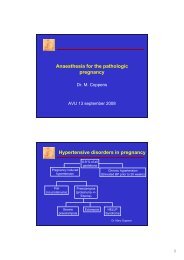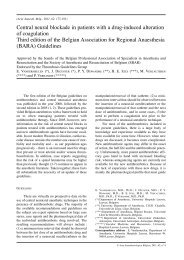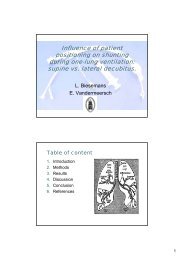Combined spinal epidural analgesia for labor and delivery
Combined spinal epidural analgesia for labor and delivery
Combined spinal epidural analgesia for labor and delivery
Create successful ePaper yourself
Turn your PDF publications into a flip-book with our unique Google optimized e-Paper software.
COMBINED SPINAL EPIDURAL ANALGESIA FOR LABOR AND DELIVERY 115<br />
frequently following CSE. Analgesia was initiated<br />
rather late during <strong>labor</strong> <strong>and</strong>, un<strong>for</strong>tunately, these<br />
authors only measured intrauterine tone <strong>and</strong> fetal<br />
heart rate <strong>for</strong> 15 minutes after the initiation of <strong>analgesia</strong>.<br />
There<strong>for</strong>e, some changes associated with<br />
<strong>epidural</strong> <strong>analgesia</strong> might have been missed. They<br />
also demonstrated that the faster <strong>and</strong> the more pronounced<br />
the <strong>analgesia</strong>, the higher the probability of<br />
abnormal cardiotocographic readings. Of course,<br />
this effect is strengthened by the simultaneous<br />
occurrence of maternal hypotension in some<br />
patients.<br />
Further study of the involved mechanism<br />
seems there<strong>for</strong>e to be required. Other mechanisms,<br />
such as direct central effects of sufentanil, are possibly<br />
involved. We can only speculate about alternative<br />
pathophysiological mechanisms. Maternal rostral<br />
spread of <strong>spinal</strong> opioids may centrally affect the<br />
release of oxytocin <strong>and</strong> subsequently induce uterine<br />
hyperactivity. It is known that intravenous opioids<br />
have central effects <strong>and</strong> alter the release of various<br />
central peptides, including oxytocin <strong>and</strong> vasopressin<br />
(140). In a recent interesting paper, STOCCHE<br />
et al. studied the release of oxytocin in women during<br />
the first stage <strong>labor</strong> <strong>and</strong> undergoing regional<br />
<strong>analgesia</strong> (153). They compared conventional<br />
<strong>epidural</strong> <strong>analgesia</strong> using plain bupivacaine 0.25%<br />
with intrathecal sufentanil 10 µg <strong>and</strong> measured<br />
maternal plasma oxytocin levels at 15, 30, 60 <strong>and</strong><br />
90 minutes after induction of <strong>analgesia</strong>. Intrathecal<br />
sufentanil decreased the plasma concentration of<br />
oxytocin. These results are in contradiction with the<br />
hypothesis that <strong>spinal</strong> opioids may induce uterine<br />
hyperactivity by modulating central oxytocin<br />
release. However, the authors themselves admit<br />
they only infrequently sampled blood. As oxytocin<br />
release typically occurs in spurts, has an extremely<br />
short plasma half-life <strong>and</strong> as the authors only per<strong>for</strong>med<br />
their first sampling after 15 minutes, they<br />
may have missed an initial increase in oxytocin<br />
release followed by the observed decrease in plasma<br />
oxytocin. More work is there<strong>for</strong>e required to<br />
elucidate the mechanism responsible <strong>for</strong> uterine<br />
hyperactivity <strong>and</strong> fetal bradycardia occurring after<br />
intrathecal opioids.<br />
It is important to note that neonatal <strong>and</strong> obstetric<br />
outcome is not affected by the use of intrathecal<br />
opioids. CARVALHO et al. failed to demonstrate any<br />
changes in fetal oxygen saturation following CSE<br />
<strong>analgesia</strong> (23). In none of the reports, emergent<br />
C-sections had to be per<strong>for</strong>med as a result of<br />
sufentanil-induced non-reassuring fetal heart rate<br />
tracings (2, 48, 75, 93, 106, 122, 162, 163, 166). In<br />
addition, neonatal outcome, as assessed by Apgar<br />
scores, umbilical artery pH <strong>and</strong> admittance to the<br />
neonatal intensive care, was unaffected by the technique<br />
used. Albright <strong>and</strong> Forster per<strong>for</strong>med an institutional<br />
retrospective survey involving 2500 patient<br />
records <strong>and</strong> observed no increase in emergency<br />
Cesarean deliveries associated to the use of<br />
intrathecal opioids (6). Only GAMBLING et al. contradicted<br />
this <strong>and</strong> reported an increased C-section<br />
rate due to more non-reassuring fetal heart rate<br />
abnormalities (57). However, also in their study,<br />
neonatal outcome was good <strong>and</strong> not different from<br />
the <strong>epidural</strong> group.<br />
TESTING THE EPIDURAL CATHETER FOLLOWING CSE<br />
Since <strong>epidural</strong> catheters can inadvertently be<br />
misplaced in either the cerebro<strong>spinal</strong> fluid or in an<br />
<strong>epidural</strong> vein, anesthetists have been using test<br />
doses to verify the correct position of the catheter.<br />
Un<strong>for</strong>tunately, test doses are neither sensitive nor<br />
specific (33, 108). Furthermore, epinephrine containing<br />
test doses can induce motor impairment <strong>and</strong><br />
thus complicate ambulation during <strong>labor</strong> (31).<br />
Some authors also suggested that an epinephrine<br />
containing test dose has potential adverse effects on<br />
uteroplacental perfusion (92). As a result, several<br />
authors suggested to ab<strong>and</strong>on routine testing of the<br />
<strong>epidural</strong> catheter, since adequate <strong>analgesia</strong> confirms<br />
the correct position of the catheter without prior<br />
testing (14).<br />
With CSE, <strong>analgesia</strong> occurs rapidly <strong>and</strong> testing<br />
the functionality of the <strong>epidural</strong> catheter is not<br />
possible until the initial <strong>spinal</strong> dose wears off.<br />
Many authors consider the fact that the reliability of<br />
the <strong>epidural</strong> catheter is uncertain during this period<br />
as a major disadvantage. Their concern is related to<br />
the possibility that the catheter may be dysfunctional<br />
when an emergency cesarean section is required.<br />
Especially in high risk pregnancies, this is considered<br />
a major drawback. However, it is important to<br />
note that, even with a well tested <strong>epidural</strong> catheter,<br />
we can never be absolutely sure that, several hours<br />
later, the catheter remains correctly positioned.<br />
Even with conventional <strong>epidural</strong> catheters, fractioned<br />
dosing or a de novo test dose are required<br />
when the catheter is used <strong>for</strong> the injection of high<br />
doses of local anesthetics.<br />
A second concern involves the fact that some<br />
authors do not want to initiate <strong>epidural</strong> <strong>analgesia</strong><br />
immediately after the <strong>spinal</strong> dose. Only when the<br />
<strong>epidural</strong> catheter is <strong>for</strong>mally tested, once the <strong>spinal</strong><br />
dose has worn off, the catheter is used throughout<br />
<strong>labor</strong>. As a result, most patients will experience<br />
© Acta Anæsthesiologica Belgica, 2009, 60, n° 2
















